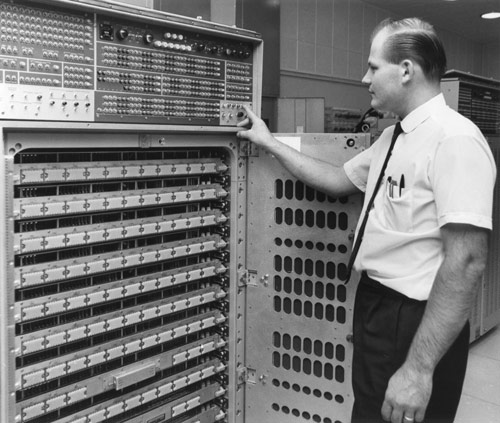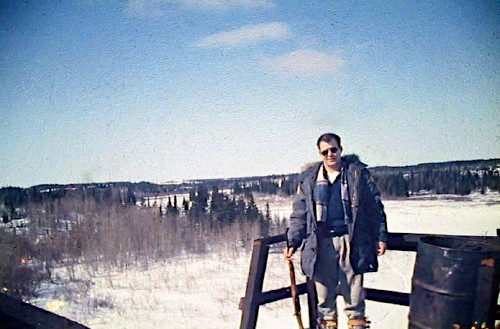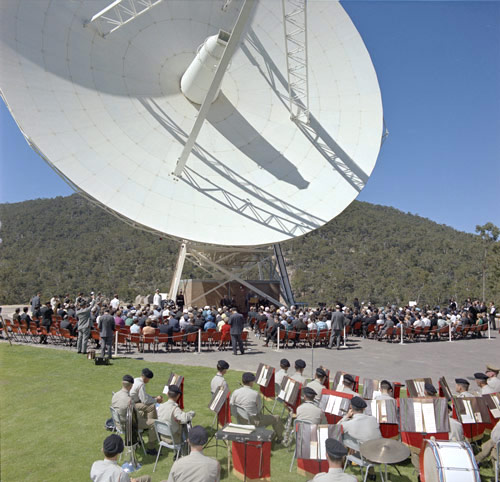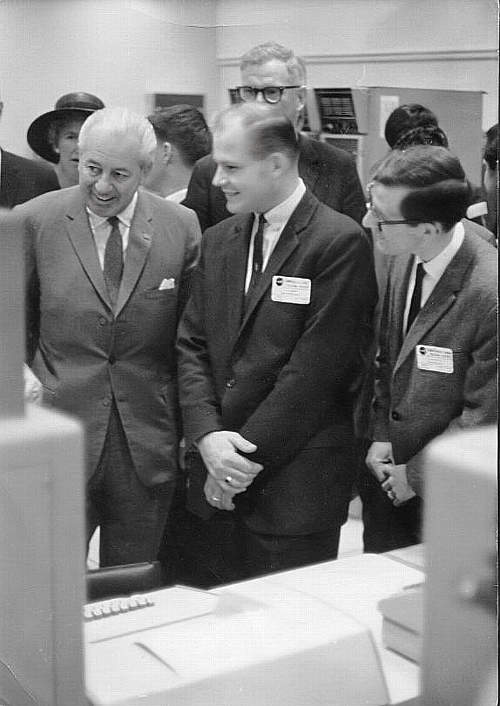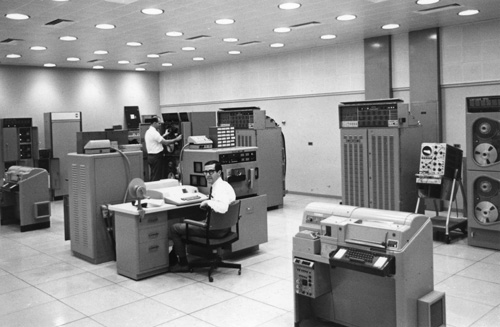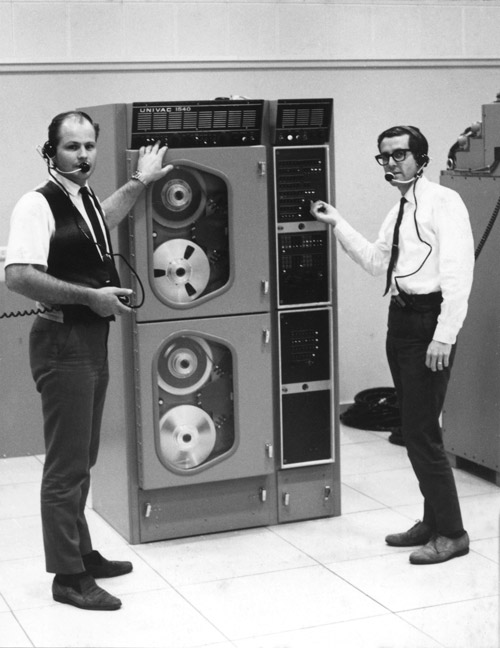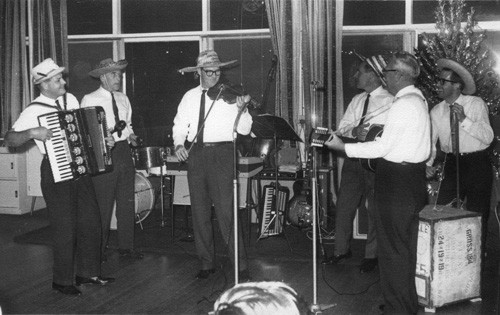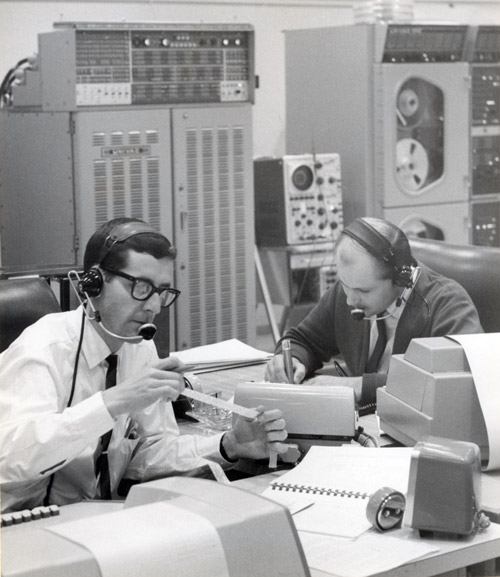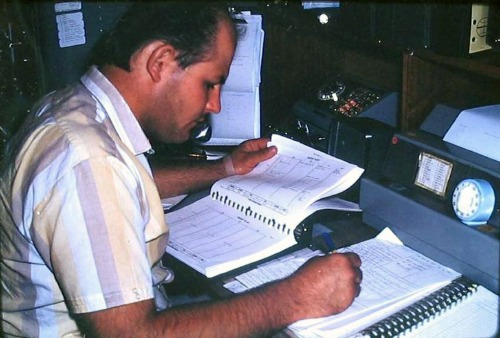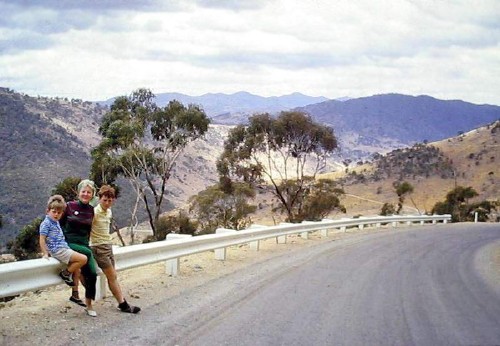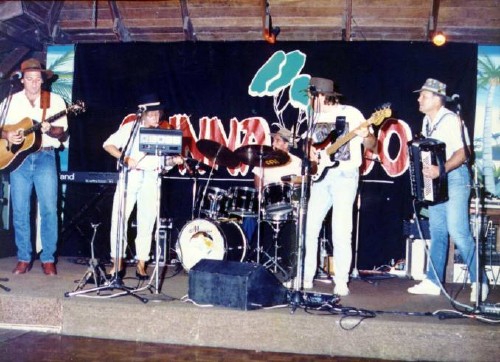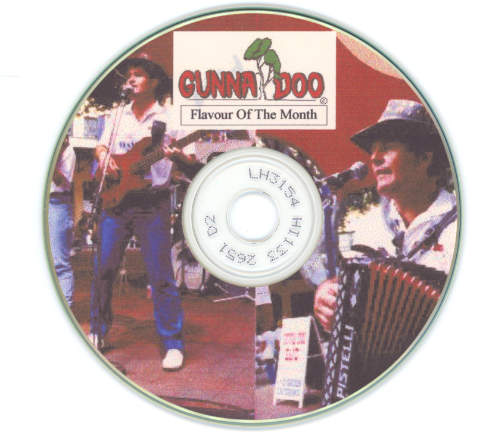Honeysuckle Computer expert Ron Hicks at one of the station’s Univac 642B computers, probably 1967.
Photo, likely by the Australian News and Information Service. Scan by Glen Nagle.
Ron Hicks
1936 – 2025
Honeysuckle Creek
Honeysuckle Computer expert Ron Hicks at one of the station’s Univac 642B computers, probably 1967. Photo, likely by the Australian News and Information Service. Scan by Glen Nagle. |
One of the original members of the Honeysuckle Creek team, Ron Hicks was born in 1936. He grew up in Moncton, New Brunswick, on Canada’s east coast.
In 1959 he graduated from the Indiana Institute of Technology with degrees in Electronic Engineering and Mathematics.
Ron then spent a year in Canada’s far north as an engineer on “The Mid-Canada Line”, an early warning radar system that stretched across the country.
|
Ron Hicks in Canada’s far
north. |
The red spot shows the location of Limestone River, Manitoba, on this 1960 map depicting the Mid-Canada Line. |
After this, Ron and a mate hitched onto a Japanese
freighter bound for Yokohama. Three months later on November 30, 1960, they
steamed into Sydney Harbour from Hong Kong via Manila.
After two years working for AWA in television, Ron
– now with a young family – emigrated to the United States. There
in the state of New Jersey he took up a position with the Union County Technical
Institute as a teacher of Physics, Mathematics and Electronics.
During this period Ron was engaged as a consultant by Bell Telephone Laboratories doing research in ultrasonics and assisting in an experiment to hit the Telstar Satellite with a beam of laser light. The ultrasonics research required that a computer program be written, so, armed with a book on Fortran, Ron began his career in computing.
Returning to Sydney in early 1965, Ron joined Standard Telephones and Cables (STC), writing tenders for large engineering projects all over the world.
When STC won the contract to man the Canberra Apollo tracking station, Ron took the position of Computer Engineer. After three months training with NASA in Virginia on Univac 642B computers and peripherals, he and his family moved to Canberra.
The Honeysuckle Creek opening ceremony on 17 March 1967. Medium format colour negative by an Australian News and Information Service photographer, preserved by Hamish Lindsay. Negative HSK-5/9/6/1-37. / LE61796. |
Ron was present for the Opening Ceremony of Honeysuckle Creek on 17th March 1967.
He and Bryan Sullivan prepared for the day by creating a computer portrait of Australian Prime Minister Harold Holt, who would offically open the station.
Ron with Prime Minister Harold Holt, and Bryan Sullivan at right – at the opening of Honeysuckle Creek, March 1967.
Read the story of The Prime Minister’s Portrait.
Ron recalls:
“Bryan Sullivan, Gordon Bendall and I started with this big empty room with a false floor. Equipment soon began arriving and over a period of a few weeks we put together a Computer Complex.
We found that some of the testing procedures, especially computer diagnostic programs supplied by Univac, were a bit lacking to put it mildly. I wrote a number of computer programs for equipment testing and submitted them to NASA. It was always a thrill for me to receive up-dated procedures manuals, which were distributed with my programs all around the Manned Space Flight Network, which read ‘Programmer: Ron Hicks, HSK.’ ”
The Computer Complex, late 1966 or early 1967, with Ron Hicks operating the Command Mag Tape unit while Bryan Sullivan is at the Input/Output model 1232 Console.
Photo preserved by Bryan Sullivan, scan by Colin Mackellar.
Ron Hicks (left) and Bryan Sullivan testing the UNIVAC Type 1540 Command Magnetic Tape Unit circa. 1966.
Photo preserved by Bryan Sullivan, scan by Colin Mackellar.
Building team morale was a key component of Honeysuckle’s success –
Ron was an enthusiastic member of Honeysuckle’s band, The Honeysuckle Honeys. Here they perform at the Honeysuckle staff Christmas Party at Canberra’s Coach House Motor Inn, Narrabundah, Friday 16 December 1966. Left to right: Ron Hicks, Fred Hill, Bill Waugh, Laurie Turner, John Talbot and Bryan Sullivan. Photo preserved by Bryan Sullivan. |
Once the Apollo missions were underway, the pace picked up considerably.
Ron was at Honeysuckle Creek for the first two manned Apollo missions.
In October 1968, Apollo 7 was the first manned flight of the Apollo Command Service Module, spending two weeks in Earth-orbit to check out the systems and performance of the spacecraft. After the tragic Apollo 1 fire the previous year, Apollo 7 was a crucial test of the redesigned spacecraft.
During Apollo 7 in October 1968, Bryan Sullivan (left) checks spacecraft command data received via a teletype tape from Mission Control while Ron Hicks makes entries in the computer log book.
Photo preserved by Bryan Sullivan, scan by Colin Mackellar.
Apollo 8, at Christmas 1968, is regarded by many who worked in the space program as the gutsiest mission of all. For the first time, astronauts rode the gigantic Saturn V launch vehicle to space – and also for the first time, they struck out to fly to the Moon.
In the photo below, from Ron’s personal collection, it is obvious that Ron and his colleagues at Honeysuckle Creek were deeply aware the momentous nature of Apollo 8 – and the risks being taken. Here they signify that Apollo 8 is “Go” to fire the S-IVB’s engine to propel the spacecraft on a trajectory to enter lunar orbit three days later.
21st December 1968 – Jim (Dutchy) Holland, Ron Hicks and Clive Cross as Apollo 8 is “Go” for Trans Lunar Injection.
Ron making notes from the Apollo 8 Flight Plan, 21 December 1968. (He is working from Page 2-6 of the Flight Plan.)
See his other Apollo 8 photos here.
Ron took this photo to mark his mother’s visit to Honeysuckle Creek in 1968. Pictured are Ron’s sons, Darren (7) on the left and Michael (14) on the right, and his mother, Edna in the middle. |
Ron moved on from Honeysuckle in 1969 to pursue an Engineering Sales career. He subsequently returned to Sydney for a couple of years and then moved back to his home town where he opened Canada’s very first computer store in 1974. Over the next eight years, as a distributor of Qantel mini-computer systems out of California, Ron and his staff developed custom software and installed and maintained the hardware.
“Back in those days, computers came without
programs, so through my software house, we developed a wide range of applications
for our clients,” Ron says.
These clients included a national pizza restaurant franchisor, a large slaughter
house and meat processing facility, several trucking firms, several accounting
firms, a greenhouse business, several insurance agents, a tombstone company,
a supermarket chain, a building materials supplier, a hardware company, a large
fishing co-operative, a stationery supplier and several manufacturing businesses.
In 1982 Ron “retired” to the Whitsundays, bought a 45-foot yacht… and Proserpine Bakeries. In his capacity of “baker”, he not only supplied the local towns with bread and pastries, but also the resort islands of Hayman, Daydream, Lindeman, South Molle and Hamilton. His connection with South Molle later led to a contract to write computer software for back-office accounting, general ledger and liquor inventory management systems for the island.
In 1983 Ron formed a three-piece “Aussie”
band with his son Darren and a well-known bush music guru, Bob Pomeroy. With
Ron’s business connections with the resort islands, the trio was in constant
demand. Over the next couple of years with the addition of the now rather famous
fiddle player, Clare
O’Meara, the band evolved into a top rate country music show-band called
The Gunna-Doo Band, playing in the local venues and on all the resort islands on a regular basis.
|
Gunna-Doo Band on stage at the Whitsunday Village, circa 1987. L-R: Mark Nicol, Clare O’Meara, Bruce Skilton, Darren Hicks, Ron Hicks. |
Ron is on the right in this image on the Gunna-Doo Band’s CD “Floavour of the Month”. |
The year 1988 saw the release of the band’s first album “Flavour of the Month.” In the following year, 1989, The Gunna-Doo Band was the Grand Prize Winner at the Queensland Country Music Awards held in Charters Towers.
After moving to Sydney from Airlie Beach in 1990, Ron started a wholesale food distribution business and, by 1996, had expanded from Sydney into country NSW and southern Queensland.
Following Ron’s development of a Membership
Accounting System for the Australian Osteopathic Association, an opportunity
arose to write computer software for the cruise boat industry. Today many operators
on Sydney Harbour are running their businesses using Ron’s “ChartSchool”
package. This success led to Ron getting the contract from (the NSW Department
of) Waterways to develop the Wharf Booking System for Sydney Harbour.
|
Ron Hicks skippering
the maxi-yacht Apollo. |
|
Ron’s other passion was flying. Here he is landing the Phoenix Aero Club’s Piper Warrior, Sierra Whisky Victor. |
Ron and Robin were frequent and welcome particants at Honeysuckle / Apollo Reunions in Canberra, travelling at various times from Queensland, Sydney and Port Macquarie.
Ron and Robin Hicks with a production Westinghouse Apollo Lunar Television Camera, at a special Honeysuckle reunion on 17 March 2006 in The Southern Cross Club in Canberra. Photo: Colin Mackellar. |
Bryan Sullivan and Ron Hicks with a Univac 1299 switch from the Honeysuckle Computer Complex at the same event. Photo: Colin Mackellar. |
In October 2007, Australia Post released a set of stamps to commemorate the 50th anniversary of the beginning of the Space Age with the launch of Sputnik 1 (4th October). Stamp launches were held in the mainland Australian capital cities, and Ron was one of those space trackers invited to take part. Here, Ron is pictured at the event at the Powerhouse Museum in Sydney with grandsons Xavier and Rainer. Photo: Colin Mackellar. |
Ron was always happy to remember the pioneering days of Apollo space tracking, and he is greatly missed by his friends and former colleagues.
